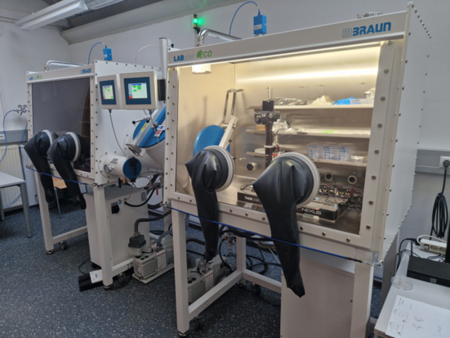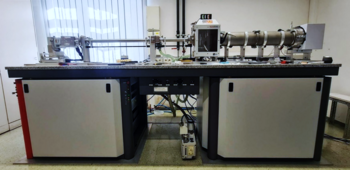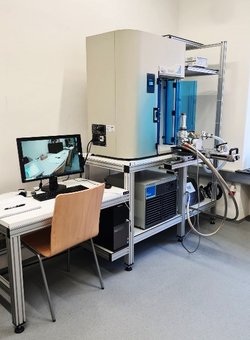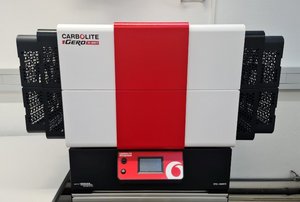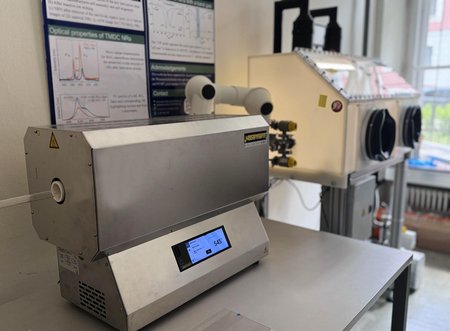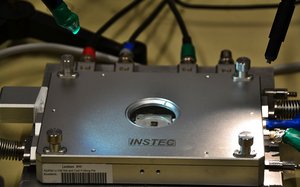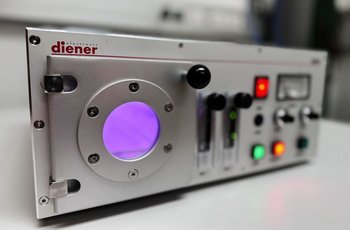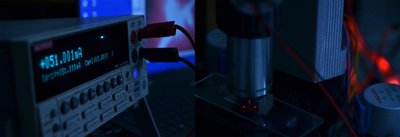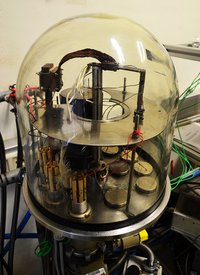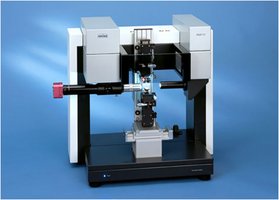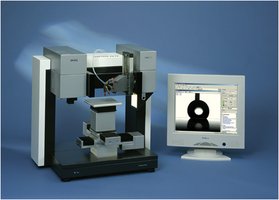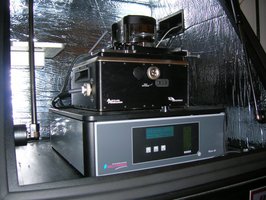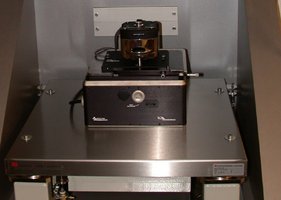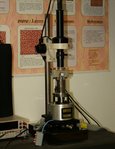Equipment
MBRAUN LabStar two unit Ar glove box system
1st unit:
2nd. unit used by MatkovicsLab custom-built motorized 2D materials stamping stage, suitable for air-senstive materials and water bubbles free interfaces. The 9-degree-of-freedom setup allows for sub-micron alignment of 2D flakes, with centric 360deg substrate rotation, and fine control over the stamp tilt and pitch angles.
Small-angle Scattering System Nanostar 1
Small-angle Scattering System Nanostar 1
Laboratory instrument for SAXS (Nanostar, Bruker AXS, Karlsruhe) with sealed-tube X-ray source (Cu-radiation), cross-coupled multilayer (Göbel) mirrors, SCATEX scatterless pinholes, and 2D Vantec 500 area detector. In-situ furnace TC-Dome adapted for SAXS available.
Small-angle Scattering System N8 Horizon
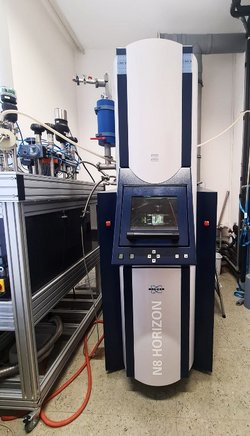
Small-angle Scattering System N8 Horizon
Laboratory instrument for SAXS (N8 Horizon, Bruker AXS, Karlsruhe) with ImS microfocus X-ray source (Cu-radiation), cross-coupled multilayer (Göbel) mirrors, SCATEX scatterless pinholes, and 2D Vantec 500 area detector. A custom-built in-situ gas-adsorption environment is attached to this instrument; presently only for room temperature operational.
Gamry Interface 1010B and Gamry Ref600 Potentiostats
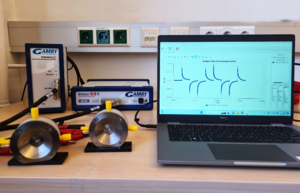
Gamry Interface 1010B and Gamry Ref600 Potentiostats
Laboratory instruments for electrochemical characterization of supercapacitors and capacitive water deionization and desalination cells. The instruments are mainly used for cyclic voltammetry, chronoamperometry and electrochemical impedance spectroscopy, both in the laboratory as well as for in-situ set-ups at large scale facilities.
X-ray diffractometer D8 ADVANCE ECO
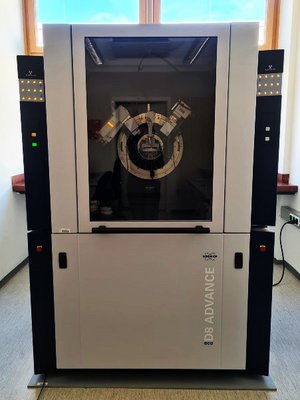
X-ray diffractometer D8 ADVANCE ECO
Laboratory instrument for powder X-ray diffraction (D8 ADVANCE ECO, Bruker AXS, Karlsruhe) with sealed-tube X-ray source (Cu-radiation), two-circle goniometer and LYNXEYE energy dispersive detector. The instrument is shared with Chair of Physical Chemistry
Low-pressure adsorption equipment Autosorb IQ
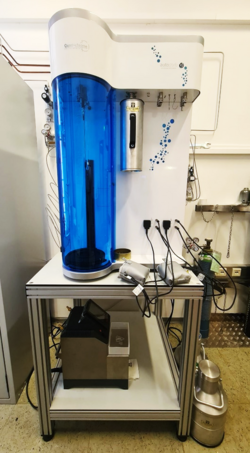
Low-pressure adsorption equipment Autosorb IQ
Laboratory instrument for low pressure gas-adsorption with 3 measurement stations (Autosorb IQ-XR-XR-AG, Anton Paar, Graz) for the analysis of nanoporous materials. The instrument allows volumetric gas adsorption experiments of different gases up to 1 bar (N2, Ar, CO2, Kr, H2, CH4….) in a temperature range from 77-115 K and ca 250-350K. Software for porosity, specific surface area and pore size distribution determination using classical- and DFT-models is available. The instrument is shared with the Chair of Functional Materials and Materials Systems and the Chair of Reservoir Engineering.
High-pressure gravimetric adsorption equipment iSorb HP1-100
High-pressure gravimetric adsorption equipment iSorb HP1-100
Laboratory instrument for high pressure gas-adsorption (ISorb HP1-100, Anton Paar, Graz). The instrument allows volumetric gas adsorption experiments of different gases up to 100 bar in a temperature range from 20 K up to 320 K (CryoCooler). The instrument is part of the Core Research Infrastructure within the Strategic Core Research Area SCoRe A+: Hydrogen and Carbon.
Helium Pyknometer Ultrapyc 5000

Helium Pyknometer Ultrapyc 5000
Laboratory instrument for the density measurements (Ultrapyc 5000, Anton Paar, Graz). The instrument allows determination of the skeleton density of solid materials using gas (mainly He) pyknometry. The instrument is part of the Core Research Infrastructure within the Strategic Core Research Area SCoRe A+: Hydrogen and Carbon.
Horizontal tube furnace up to 1600° CTF3 16/100/450, Carbolite Gero
Horizontal tube furnace up to 1600°C
Laboratory furnace with 3-zone heating (TF3 16/100/450, Carbolite Gero, Neuhausen). The furnace is mainly used for the calcination, pyrolysis or activation of carbons or carbon precursors in vacuum, inert gas, or activation gas up to a temperature of 1600°C. The furnace is part of the Core Research Infrastructure within the Strategic Core Research Area SCoRe A+: Hydrogen and Carbon
Workspace for the production of electrodes
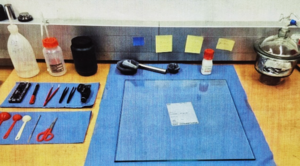
Laboratory workspace dedicated to the production of flexible electrode sheets of variable thicknesses (100 µm – 1 cm) from powderous raw electrode material (carbon or metal organic framework) using a roll press and PTFE binder.
Small-angle Scattering System Nanostar 2
Small-angle Scattering System Nanostar 2
Laboratory instrument for SAXS (Nanostar, Bruker AXS, Karlsruhe) with extra-large (XL) sample chamber; ImS microfocus X-ray source (Cu-radiation), cross-coupled multilayer (Göbel) mirrors, SCATEX scatterless pinholes, and 2D Vantec 2000 area detector. Image plate detector for wide-angle scattering and GISAXS stage available. The instrument is shared with Chair of Materials Physics and the Department of Polymer Engineering and Science.
Transfer stage
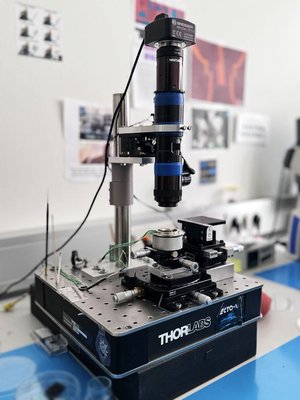
Transfer stage
The system is custom-built tube lens system with several micromanipulators for stacking of various 2D materials into heterostructures under ambient conditions. The sample/substrate stage has 360 degree centric rotation feature with below 0.1 degree precision, and controllable heating option. Stamp carrying stage has five degrees of freedom, xyz translation, tilt, and pitch. Lateral precision for the stacking of flakes is usually below 1 micrometer. The system is also used for silver epoxy based bonding of the devices.
Nabertherm Compact tube furnace
Nabertherm Compact tube furnace
The furnace is employed in a chemical vapor deposition (CVD) setup targeting the growth of TMDCs on various substrates, as well as for recrystallizing and initiating phase transitions in phyllosilicates. The setup is equipped with Ar/H2 carrier gasses, and sulfur/selenium sources. The system is designed for both dry and wet transition metal precursor use, and is connected to an Ar/low-vacuum glovebox for sample exchange.
Instec Microprobe Station
Instec Microprobe Station
The micro probe station operates under ambient or under low vacuum (1e-2 mbar), with four Au/Pd probes, and sample cooling/heating stage. It can operate under liquid nitrogen (77 K) and up to 673 K. The system is connected to a Kethley dual-source unit, and is dedicated mainly for characterizing the electrical properties of 2D materials-based devices. The system can be combined with external permanent magnets, reaching up to 120 mT fields in an out-of-plane configuration. Further, the system is possible to combine with confocal microscopes of spectroscopic setups. This can allow for e.g. for simultaneous Raman and transport measurements, or measurements of electroluminescence.
Nanoparticles deposition setup
Nanoparticles deposition setup
The setup is based on a home-built laser engraver with multiple wavelength options. The system is employing 3D printed parts for the tube lens construction and automated sample scanning stage. It is dedicated to controllable photocatalysis of metallic nanoparticles, and laser patterning with below 10 micrometer lateral resolution.
AIST NT ambient atomic force microscope
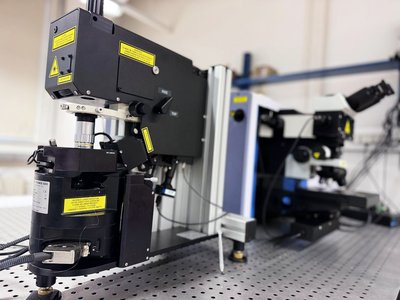
AIST NT ambient atomic force microscope
coupled to Horiba Labram Evolution spectrometer, TERS capability, and as 2D Mat_Lab specialty in-operando frequency modulated KPFM.
Rohrstoffmineralogie equipment in cooperation with Chair of Physics.
Hot Wall Epitaxy chamber for organic semiconductor growth
Hot Wall Epitaxy (HWE) chamber is a custom built high vacuum (1e-6 mbar) system, dedicated to growth of organic semiconductor thin films and nanostructures. It equipped with multiple organic semiconductor sources (max two at a time), as: parahxaphenyl, dihydrotetrazaheptacene, dihydrotetrazapentacene, C60 fullerene, and zwitterion small organic molecules. In addition, it is possible to grow on operational transistors and record electrical responses as the films form. Further, there are Peltier cooling elements for growth at lower sample temperatures, and mounts for laser diodes for the growth during controlled illumination of the sample surface (photo-modulated growth).
Contact Angle Device Krüss DSA100M
Drop shape analysis device used for dispensing pico liter droplets. Due to the need for creating droplets smaller than 1µl we purchased together with Joanneum Research this second drop shape analysis device from Krüss.
Equiped with a piezo driven dispenser and a microscope for drop visualization it is capable of measuring the contact angle of water droplets with a volume of only 100pl. The resulting small droplet in the µm size allows investigation of surface patterns and paper fibers and much more.
Contact Angle Device Krüss DSA100
Drop shape analysis device from Krüss, mainly used for free surface energy determination. The first of our two drop shape analysis devices. We use this machine mainly for determination of surface free energy of solids.
The system is equiped with an revolver that allows dispensing of four standard test liquids. In our case these are water, diiodmethane, ethylenglycol and 1-bromnaphtaline. Furthermore, the system is equiped with a heating chamber that also allows to create an intert gas atmosphere.
In two consecutive Proficiency Test (2007, 2008) organized by the ofi our lab has finished within the best 5 labs out of 19-25. within all subtest we alwas had the best possible performance of very good.
Atomic Force Microscope Asylum Research MFP-3D for polymers
This MFP 3D system has been aquired together with the department for Materials Science and testing of plastics (Ao. Prof. Dr. Wallner). It is mainly used for investigating polymers and biological materials. In comparison to the other MFP 3D it has possible to use a PolyHeater for varying the temperature up to 300 °C. Additionally it has an active anti-vibration table from Halcyonics (Micro 40). The system is shared with the collegues from the plastic engineering department.
Atomic Force Microscope Digital Instruments Multimode
Nanoscope III Multimode AFM from Digital Instruments is used for studying of various surfaces, among those are surfaces of semiconductors, metals, etc. It is well equipped with the set of cantilever holders, scanners and Q-modulator it can operate in few modes, such as: tunneling, contact mode AFM, tapping mode AFM, tapping mode in fluids, lateral force mode, conductive probe, electric force imaging and others.
UHV Omicron AFM/STM
UHV AFM/STM for C-AFM and in-situ investigation of organic thin films.
The system is based on the Omicron UHV AFM/STM. The old Solaris controller has been replaced by a modern custom build controller from Anfatec. The new controller now also allows to use all the dynamic modes more easily. Furthermore, the system is equipped with some limited thin film growth equipment. This includes a resistive evaporator for organic materials from Dr. Eberl, a quartz crystal balance, a home build electron gun heater and an ISIS3000 ion source for structuring and cleaning of samples.

